






Lt Gen Syed Ata Hasnain(Retd)
The incident at Handwara panned out in a manner that was typical of a deep-set conspiracy to bait the Army. Targeting and burning of the bunker was deliberately done to invite response. The Army’s could not have given a benign response as the safety of its men was involved.

A dangerous situation is unfolding in Kashmir and it appears a deliberate attempt to up the ante. It was predictable to any one who observes the Jammu and Kashmir situation on a regular basis. South Kashmir was far too volatile and the north far too quiet over the last few months. The conditions were ideal for a return to the street turbulence witnessed during 2008-10. Sopore, Handwara, Baramula and Pattan are competing centres for attention. Bandipura too has been without political or terrorist activity for some time. All of them have distinct separatist bases with a large cadre of over ground workers (OGWs). Terrorist strength has dwindled due to an effective anti-infiltration grid and effort of the security forces in the hinterland. Separatists cannot afford to allow their movement to flag off beyond a certain threshold and the youth-based militancy in south Kashmir is increasingly out of control of the United Jehad Council with whom the separatists have a good working linkage. The stamina of the public for another round of street turbulence has resurged. This was evident from the manner in which mobs attempted to intervene in the operations of the Army’s Victor Force in south Kashmir and turned out to pay tribute to dead terrorists. The local media has largely been eulogising the terrorists in south Kashmir, with pro- separatist commentaries. The return of a government also triggered the idea of agitation. With Governor’s rule an agitation loses its political effect and the response by the state is far more robust. With an elected government in place the situation helps to create hype; response comes under scrutiny and with a coalition government dissensions increase on how to handle the turbulence Separatists create situations in which the security forces are offered few options but to respond. Recall how the Muzaffarabad March of August 11, 2011, was set up and Sheikh Abdul Aziz was virtually led to his death through a conspiracy. His death is still believed to have been at the hands of terrorists concealed in the mob. The manner in which the recent Handwara incident panned out was typical of a deep-set conspiracy to bait the Army. The targeting and burning of the bunker was done deliberately to invite response. The Army could not have had a benign response as the safety of its men was involved. The attention of the Army will shift to internal security and the terrorists and their handlers will hope that the anti-infiltration grid will be less focused allowing more terrorists to infiltrate, leaders to be brought in and the critical supply of arms and ammunition replenished. Separatists want India and Pakistan to talk but perceive that their own role is being marginalised, hence the necessity to project their relevance. Street power is considered an appropriate means to draw attention. If the India-Pakistan peace process does progress, the importance of Handwara- like situations will enhance — with separatists constantly seeking their space.The spiralling violence is a part of the overall plan of action and reaction. Cadres are usually on the ready for this and professional rabble-rousers move from town to town, with teams of stone throwers. The Baramula agitation, for example, is almost entirely instigated from Sopore and carried out by the Pattan youth. The Army has the experience to handle this although many of the officers and jawans may be new to this game due to turnovers. However, there is an institutional memory and the JK police will help in briefing them on past responses. The Army must keep itself out of the agitation as in the past, notwithstanding deliberate attempts this time to bait it. This is not a conventional internal security situation. Remember, the Army is on a counter-terrorism grid. Flag marches will have to be dispensed with as this brings the mobs in contact with soldiers. The CRPF and JK police have enough experience but must ensure that a repeat of 2010 is avoided at all cost. The optimum amount of anti-riot gear is learnt to be still eluding these forces for which responsibility must be fixed. Senior police officers have to ensure that their sub units are never too small to get isolated and, therefore, targeted.My personal experience tells me that the clergy plays a crucial role in subsiding tempers. The Amir e Jamat of the Jamat e Islami (K), who is located at Kulgam in south Kashmir can play a positive role. In such mass agitation, a sane voice will help and his services must be requested. If need be, SAS Geelani and his ilk should be physically isolated and prevented from accessing any communication resources such as mobile phones. His bandh calls had reached a point where no one was responding to them. Obviously Handwara is a method to regain his lost space.All the above is well said and is fine as an approach towards prevention of a negative situation followed by avoiding worsening if it occurs. However, there is an element within the separatists and a very influential one which is instigating an irrational approach. It is catering for a conventional benign Army response of controlled use of violence. The overall response of the security forces has been relatively benign, although some may term my usage of the word as an oxymoron. It’s not easy to be facing mobs and attempting to be “good guys”. Before long, tempers will have flared. In 2010, Geelani was initially ill- advised to increase the pitch of the agitation by targeting Army camps. When a veiled warning from the Army was received, he sensibly held back.It seems this time the separatists have concluded that the Army will be benign and defensive so as not to draw the ire of human rights activists. Those promoting violence on the streets need to be aware of the phenomenon of unpredictability which the Army follows as an essential principle of security. In needling the Army, the separatists may just cross the threshold. It is their intent to sacrifice a few lives in the street to raise passions but beyond a point they too realise that loss of lives flags down a movement rather than take it forward.There is a dire need for messaging at this time. The parents must know that their sons in the streets are being instigated. Even with best of intentions of the security forces, lives will be lost if a threshold is crossed. Is it difficult to get this message across? Perception management isn’t the strongest area of any government establishment but this time sincere efforts must be made to shift blame squarely to the perpetrators who care least for young lives.Some elements of the local media are attempting to egg on the new government to take a hard stance against the security forces. The Army Commander has made an early visit to ascertain and be briefed. This is the time when the political leadership and the Army need to be demonstratively on the same page. Separatists and elements of the negative media will paint perception of division of opinion and attempt to project the CM as anti-people. This must not allow the working to be dented. The Durbar is still at Jammu but an advance element of the government must move to the Valley to nip the happenings in the bud. If not, there will be no rest this summer in the salubrious environs of the pristine Valley. The writer, an ex General Officer Commanding of the Srinagar based 15 Corps, is now a Fellow with Vivekanand International Foundation & Delhi Policy Group.
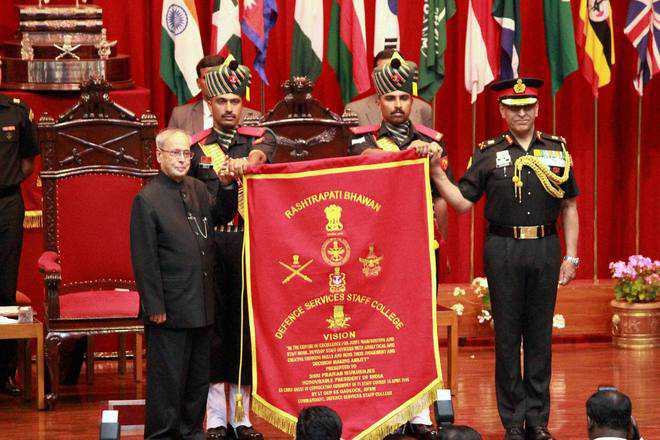
President Pranab Mukherjee on Friday presided over the graduation ceremony of the 71st Staff Course at Defence Services Staff College at Wellington, Tamil Nadu. As many as 458 officers, including 34 from 25 foreign countries, graduated from the college Addressing the graduating officers, the President asked them to be well versed about the history of various conflicts and latest technology available in the modern world for successful military operationsHe urged the officers to use their learning with prudence to effectively leverage the combat power of the Indian armed forces in times of national need. “As your supreme commander, I implore you to do this with total loyalty, dedication…”
Tribune News Service
Chandigarh, April 11
It’s good news for all Central government pensioners who retired prior to 2006. Reason: The clause of pro-rata reduction in pension for those who did not complete 33 years of service has been done away with and they would now get enhanced pension, along with arrears, equal to those who retired in 2006 and thereafter.While the provision of having 33-year service for earning full pension was done away with in 2006 on the implementation of the Sixth Pay Commission, this benefit was not extended to pre-2006 pensioners and till date, the pension in cases with less than 33 years of service was being calculated with proportionate reduction. Orders to this effect were issued by the Department of Pensions and Pensioners Welfare on April 6, after the orders of the Central Administrative Tribunal de-linking the service requirement of 33 years for grant of full pension, were upheld by various high courts and finally the Supreme Court.“The arrears of revised pension would be payable with effect from January 1, 2006,” the orders add. The new orders will financially benefit a large number of government pensioners across all hierarchical levels all over the country, especially those who opted for voluntary or premature retirement and those released from service on medical grounds before completing 33 years of service.
SANJHA MORCHA has gone into joint venture for opening of Departmental store ,Thus created an opportunity for
Self employment of Ex-Servicemen and their dependents as
employees .
A First Sample store is ready at Ambala Cantt in the complex of Golden Loin Canteen has been created under the close supervision of Col Sandeep Bhanot, President Haryana Unit of Sanjha Morcha.

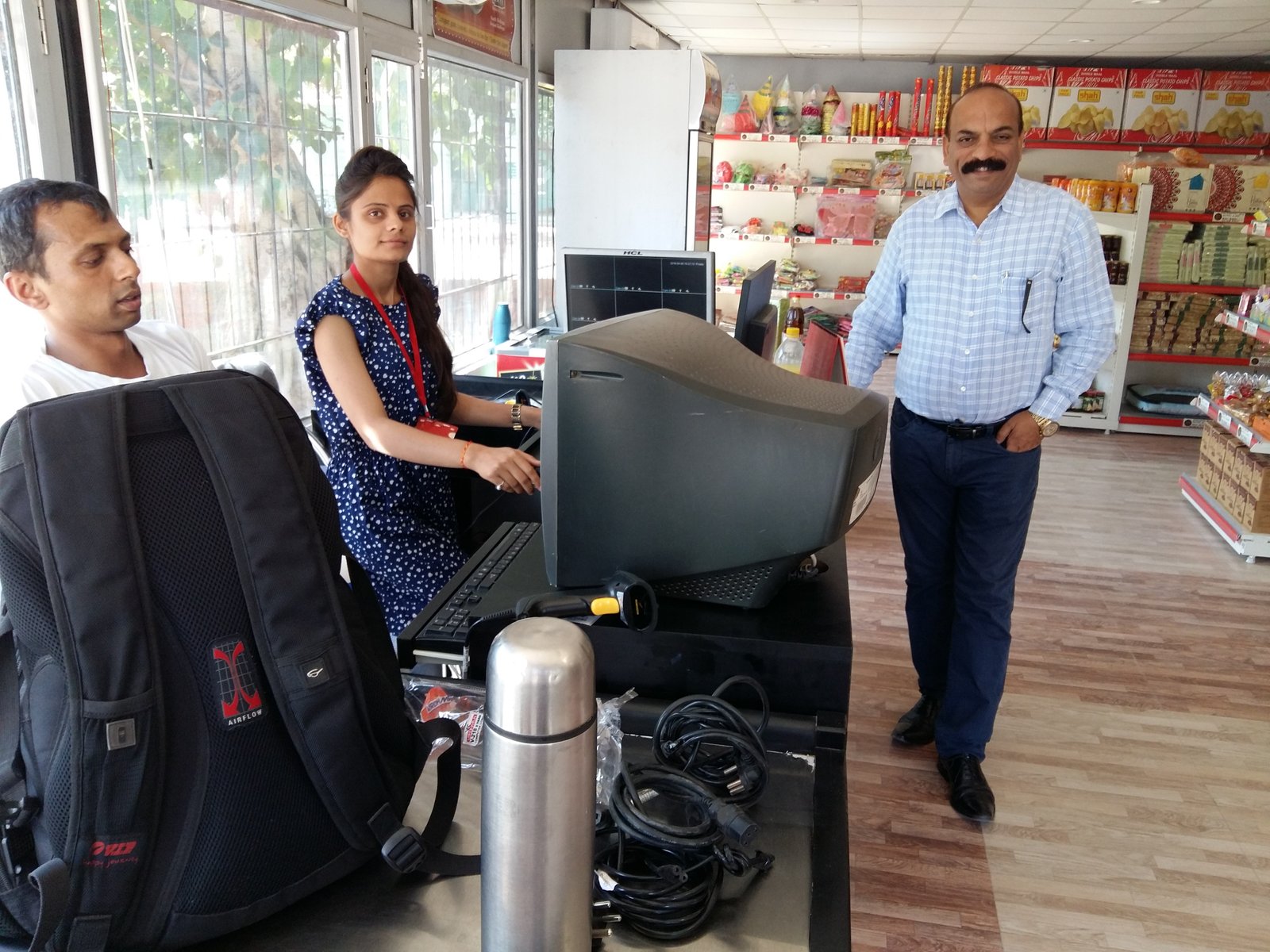

NEW DELHI : The military personnel henceforth taking voluntary retirement as a request shall not be entitled to the One Rank One Pension (OROP) applicable to those retiring up to July 1, 2014, the date fixed for its implementation.
While the pension of the defence personnel will be re-fixed henceforth every five years, the Justice L Narasimha Reddy-headed judicial committee will help remove anomalies that may arise in implementation of the OROP order issued on November 7 last. Retired Patna High Court Chief Justice Reddy was appointed on December 14 to give the report within six months on the references made by the Government in lieu of objections by the ex-servicemen’s organisations.
The government clarifications came on Wednesday when the Union Cabinet gave its ex-post facto approval of implementation of the OROP.
It said: “Pension will be re-fixed for pre 1.7.2014 pensioners retiring in the same rank and with the same length of service as the average of minimum and maximum pension drawn by the retiree in the year 2013. Those drawing pensions above the average will be protected. The benefit would also be extended to the family pensioners, including disabled pensioners and war widows.” The financial implication of the implementation of OROP is Rs 10,925.11 crore for payments of arrears while the annual burden would be Rs 7488.7 crore.
The arrears are to be paid in four half-yearly installments, the first such installment of total Rs 2861 crore was disbursed to 15.91 pensioners till March end, the officials said.
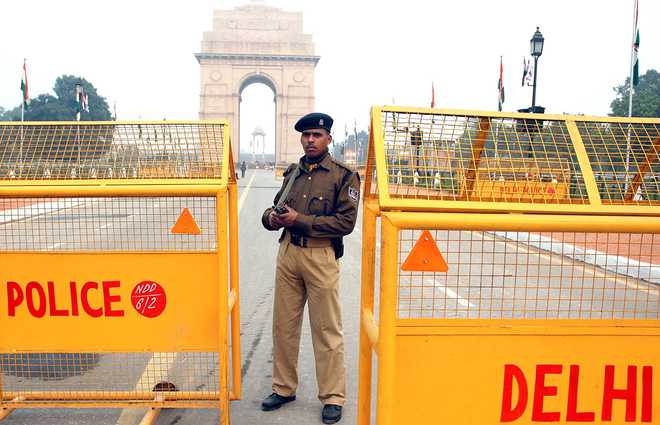
Chandigarh/Gurdaspur, April 6
The Special Cell Delhi Police has sounded a terror alert saying that a grey coloured Swift Dzire with Jammu and Kashmir registration number carrying three Pakistan terrorists with explosives may target Delhi, Mumbai or Goa.“Input received from Special Cell Delhi Police that a grey coloured Swift Dzire carrying three Pak militants and a local …with arms, ammunition and a possibly suicide belt is likely to cross Banihal Tunnel later tonight today,” said DGP Law and Order, Punjab, Chandigarh.Their target could be in Delhi, Goa and Mumbai. Security alert has been issued, said the DGP.Meanwhile, Pathankot and Gurdaspur police districts have also been put on high alert following inputs from Delhi police special cell about possible infiltration of three terrorists into Punjab from Jammu & Kashmir. Check posts have been fortified in both police districts.Punjab has witnessed two major terror attacks in the past nine months.Suspected Pakistani terrorists attacked the Pathankot Indian Air Force base on January 2 and killed seven security personnel.On July 27 last year, three suspected Pakistani terrorists attacked Dinanagar town in Gurdaspur district leaving seven people dead.Both attacks took place in areas of Punjab bordering Jammu and Kashmir. — TNS/Agencies
With Pakistan India can only hope for the best but be ready for the worst
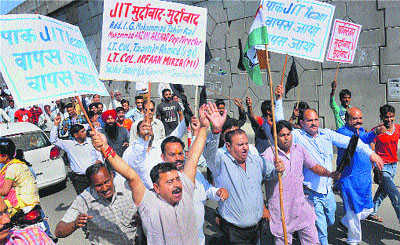
CRICKETERS believe that if India and Pakistan were to play more games, it would help both countries to live in peace. They do not realise that at political and diplomatic levels too, both nations play games. This game is called one-upmanship, with surprise as an important element. Lately, this game has become frequent and intense. We had both prime ministers speaking to each other in whispers in Paris. That was followed by national security advisers and foreign ministers breaking bread with their counterparts. On Xmas day, Prime Minister Modi scored huge points with a surprise stopover in Lahore to greet his counterpart. A week later, Pakistani Jaish-e-Mohammad (JeM) fidayeen surprised us with a daring attack on the IAF air base in Pathankot. Now, it is the turn of intelligence agencies. While India hosts Pakistan’s Joint Investigation Team (JIT), Pakistan is hosting and feting (appears that way in the TV clip released by Pakistan) a former Indian Naval officer as a spy. The JIT visit to the Pathankot airbase will neither compromise our security nor make any dent on Pakistan’s policy of cross-border terrorism. On the plus side, it may lead to matching reciprocity and a small diplomatic advantage. On the minus side, China blocking India’s move to place ban on JeM chief Azhar Masood, the mastermind of the Pathankot terror attack, makes it obvious that Pakistan will take no action against him and his terror outfit. The Lashkar and Jaish perpetrators may feel encouraged with India’s soft, ethical response, which like the 26/11 case will lead nowhere. All this will carry some political cost for the Modi government within India.The spy episode is intriguing, in the revealed details as well as its timing. The revealed details — former Naval Commander Jadhav’s presence in Baluchistan with an Indian passport, his video recorded confession and demeanour — are most unprofessional (for a spy) and unconvincing. Pakistani ‘respect’ for such a spy is hard to believe. I cannot forget the horrible treatment meted out to Capt Saurabh Kalia’s patrol in Kargil, and of Indian soldiers captured elsewhere. Its timing and publicity too raises questions. Was it timed by the Pakistani security establishment to force Sharif’s hand on Modi-Nawaz talks scheduled in Washington? Three days after the spy episode, Nawaz Sharif called off his Washington visit due to Easter Sunday’s terror incident in Gulshan-e-Iqbal Park, Lahore. Was it to cover its intelligence failure in the Easter terror attack? Or to scuttle joint investigation post Pathankot incident?How will these tactical incidents impact Indo-Pakistan relations or India’s Pakistan policy? For this, we need to coldly assess what is happening within Pakistan.From all accounts, it is evident that the Pakistan army remains Indo-centric and in control of Pakistan’s engagement with India. It challenged the Indo-Pakistan joint statement at Ufa, which gave primacy to counter- terrorism in our disputes. It forced the government to change tack and make Kashmir the number one agenda point. In recent months, it has been obsessed with ‘Indian interference in Baluchistan’. A few days ago, the director-general of Inter-Services Public Relations, Lt Gen Asim Bajwa, had said Gen Raheel Sharif, Pakistan army chief, had shared his concern with Iranian President Rouhani that ‘RAW is involved in Pakistan, especially in Baluchistan, and sometimes it also uses the soil of our brother country Iran’. Such a discussion was promptly denied by the Iranian President and Iran’s ambassador in India.On March 31, 2016, a well-known Pakistan daily wrote that Asim Bajwa’s recent tweets and statements have exposed civil-military tensions. The report observed “This situation tends to undermine the civilian supremacy as guaranteed by the constitution and gives the impression as if the military is acting like a supra-governmental body over and above the country’s chief executive.”When Pakistan introduced the anti-terror National Action Plan (NAP) and amended its constitution, apex committees (ACs) were created to supervise the implementation of NAP. The ACs are dominated by army officers and have become another irritant in Pakistan’s civil-military relations.As evident from the Easter terrorist attack in Lahore which claimed 74 lives, mostly Christian women and children, the sectarian divide within Pakistani heartland has increased considerably. The Sunni ultras were targeting Shias and Ahmadiyyas for some time. Now, armed with blasphemy laws, the Sunni majority has begun to terrorise Pakistan’s religious minorities also.In 2011, when Malik Mumtaz Hussain Qadri killed his boss Salman Taseer, Governor of Pakistan Punjab, for defending a Christian woman who had fallen afoul of Pakistan’s blasphemy laws, he became a hero. A mosque was named after him in Islamabad. People came to see him in prison to seek his blessings. The judge who sentenced him to death had to flee the country. When Qadri was hanged, despite media blackout, over 1,00,000 people poured into the streets of Rawalpindi to bid him farewell. Describing that spectacle, well-known author Aatish Taseer, writing in The New York Times, observed that the ideology of hate had infected the body of the (Pakistani) people. “What do you do when the madness is not confined to radical mosques and madrasas, but is abroad among a population of nearly 200 million?” Last week, Qadri’s supporters launched another agitation outside Pakistan’s Parliament House and other key installations. Led by the Sunni Tehreek and Tehreek-i-Labbaik-Ya-Rasool, over 25,000 supporters demanded the implementation of Sharia in Pakistan and Qadri to be declared a martyr!It is evident that the current Pakistani political leadership is sandwiched between the Pakistan army with its vice-like control over national security policies, and the growing Islamist militant and non-militant movements. Both of them see India as an adversary — for common as well as some different reasons. Atal Bihari Vajpayee once said: “Over the last 55 years, every initiative for a dialogue with Pakistan has invariably come from India.” This statement reflected India’s frustration in its endeavour to develop good neighbourly relations with Pakistan. While there is no alternative to remaining engaged with such a geographical neighbour, dramatic gestures or a few summit meetings with its sandwiched political leadership are unlikely to bring lasting peace. When diplomacy does not work, changes in the psyche and attitude of nations occur through all-out conflicts and/or economic disparities. Since an all-out conflict with Pakistan is ruled out, India must focus on the economic strategy. Meanwhile, it would have to live with the ugly stability and reciprocal violence. One must hope for the best in a gradual, incremental dialogue process, but remain prepared and alert for the worst
. Gen VP Malik (Retd)
— The writer is a former Army Chief
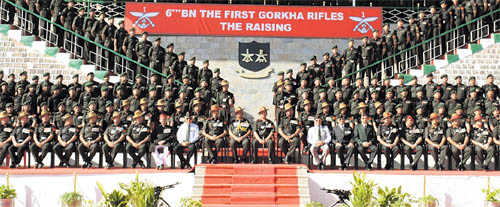
Vijay Mohan
Tribune News Service
Chandigarh, April 2
The Army has turned over a new leaf by raising a new Gorkha battalion comprising entirely of Gorkha troops of Indian domicile. Traditionally, the majority of troops in Gorkha regiments belong to Nepal.This is the first Gorkha battalion to have come up in 50 years. The new battalion, the Sixth Battalion of the First Gorkha Rifles (6/1GR), christened “Kanchi Paltan”, has been raised at Sabathu in the Shivalik foothills near Shimla, that houses the 14 Gorkha Training Centre.In 1815, the British had raised the first Gorkha battalion, 1/1 GR, from the remnants of General Amar Singh Thapa’s forces following the Gurkha War fought between the Gorkha kings of Nepal and British East India Company.Col Avaneesh Chambial is the battalion’s first Commanding Officer. The recruits for the battalion had been undergoing training at the centre for the past nine months and the battalion’s regimental flag was unfurled by the Colonel of the First Gorkha Rifles, Lt Gen Ravi Thogde, at a ceremonial parade on Friday.The Army has several Gorkha regiments — 1GR, 3GR, 4GR, 5GR, 8GR, 9GR and 11 GR. The stipulated ratio of composition of these regiments between Nepalese and Indian domicile Gorkhas is about 70:30. In some units it is 60:40.The Army’s plans are that each Gorkha regiment will raise an additional battalion in due course as part of the approved force accretions and the ongoing organisational restructuring.A senior officer said more Gorkhas of Indian domicile i.e. those settled in the hilly regions of northern India and the North-East and even other parts of the country would be recruited and Gorkha regiments were envisioned to have a pan-India footprint. The minimum educational qualification for Gorkha troops was also being raised from matriculation to Class XII.Three years ago, the Army had raised the Sikkim Scouts comprising locally recruited youth from the state for deployment in the border regions. The unit has been affiliated with 11 GR.
The writer is Distinguished Fellow, Institute for Defence Studies and Analyses, New Delhi
The views expressed are personal
Speaking at the Raisina Dialogue earlier this month, Admiral Harry Harris, Commander-in-Chief, US Pacific Command, called for quadrilateral Australia-India-Japan-US consultations for peace and stability in the Indo-Pacific region. He said, “Together, we can develop a roadmap that leverages our respective efforts to improve the security architecture and strengthen regional dialogues. Together, we can ensure free and open sea lanes of communication…”
REUTERSUS military forces engage in an Amphibious Assault Vehicles (AAV) manoeuvre in the South China Sea near northern Philippines, April 21, 2015Harris also announced that the next set of naval exercises in the trilateral annual Malabar series, comprising India, Japan and the US, will be held in the northern Philippine Sea, close to the South China Sea. The Chinese perceive such efforts as attempts to gang up on them and, therefore, their reaction was fast and furious. A spokesperson of China’s foreign ministry said, “We urge the US government to put some restraint on them (US commanders) and stop them from irresponsible sensationalisation and hyping up so as to avoid undermining regional peace and stability.”
China senses the emergence of a security vacuum in the Indo-Pacific and is rushing to fill it. Beijing has discarded Deng Xiaoping’s 24-character strategy to ‘hide our capacity and bide our time’. It has dropped the phrase “peaceful rise” while referring to its economic growth and military assertiveness.
China has deep internal fault lines. Its rapid economic growth, now slowing, has been uneven and non-inclusive. There is a deep sense of resentment of the Communist Party for the denial of basic freedoms. The discontent could boil over and lead to an uncontrollable spontaneous implosion. David Shambaugh, a well-known China scholar, is among those in the China-may-implode school. The recent crash of Chinese stock markets and their continuing volatility point to the possibility of a meltdown.
Most Asian leaders are apprehensive of China’s intentions and worry that it may behave irresponsibly somewhere in the IndoPacific. It could decide to intervene militarily in the South China Sea, or to occupy one or more of the disputed Senkaku/Diaoyu islands or decide to resolve the remaining territorial disputes, like that with India, by using military force. Though President Xi Jinping has denied plans to ‘militarise’ the South China Sea, surely China is not building air strips there to fly in Japanese tourists.
Both the contingencies — implosion and military adventurism — have a low probability of occurrence, but will be highimpact events with widespread ramifications should either of them come to pass. In such an eventuality, both India and the US will need strong partners to deal with the fallout and to manage the consequences. Hence, the India-US strategic partnership makes eminent sense as a hedging strategy.
India must join the US and other strategic partners, such as Australia, Japan, Singapore, South Korea and Vietnam, to establish a cooperative security framework for peace and stability in the Indo-Pacific and for the security of the global commons — air space, space, cyber space and the sea-lanes of communication — to enable freedom of navigation and free flow of trade. If China is willing to join this security architecture it should be welcomed. However, it is unlikely to do so as it believes that ‘one mountain cannot contain two tigers’ and sees itself as the lone tiger on the Asian mountain.
US leaders have expressed their support for India’s emergence as a major power several times. They have said the US is committed “to help India become a major world power in the 21st century”. President Barack Obama declared in 2010 that “India is not just a rising power, it has already risen”.
The US hopes India will soon become a “net provider of security” in the region. The expectations include India joining international counter-terrorism and counterproliferation efforts; sharing intelligence; upholding the rules and norms governing maritime trade; providing help to the littoral states to meet their security needs; helping to counter piracy and narcotics trafficking; and, continuing to taking the lead in humanitarian and disaster relief (HADR) operations in the region. All of these expectations are unexceptionable and India has been contributing extensively to achieving these common goals.
India must not hesitate to intervene militarily in conjunction with its strategic partners if its vital national interests are threatened in its area of strategic interest. This extends from the South China Sea in the east to the Horn of Africa in the west. India would prefer to intervene under the UN flag but may join a coalition of the willing in case consensus is difficult to achieve in the UN Security Council. India must develop robust tri-Service capabilities for military intervention.
India-US defence cooperation, a key component of the strategic partnership, must be enhanced to take it to the next higher trajectory to enable the two countries to undertake joint threat assessment; contingency planning for joint operations; sharing of intelligence; simulations and table-top exercises — besides training exercises with troops; coordination of command, control and communications; and, planning for operational deployment and logistics support. All of these activities must be undertaken in concert with India’s other strategic partners in Asia.
Only when a cooperative security framework is in place will the India-US strategic partnership realise its true potential as a force for peace and stability in the IndoPacific.






















































